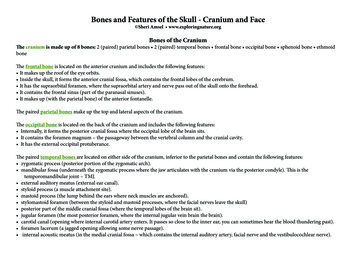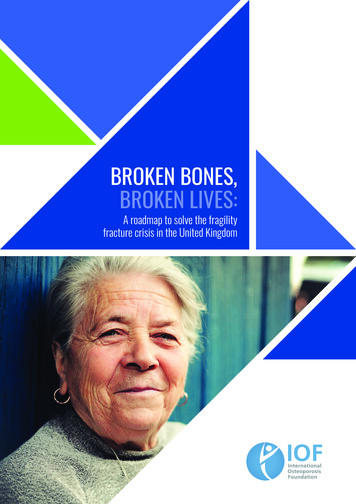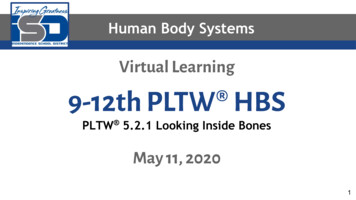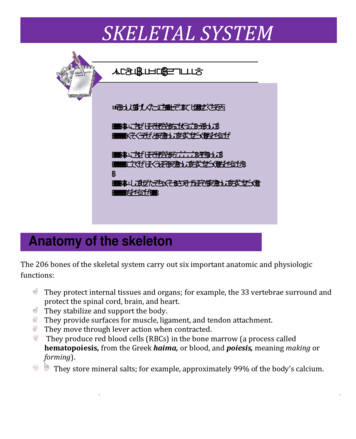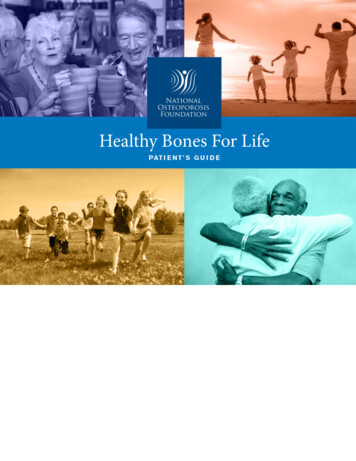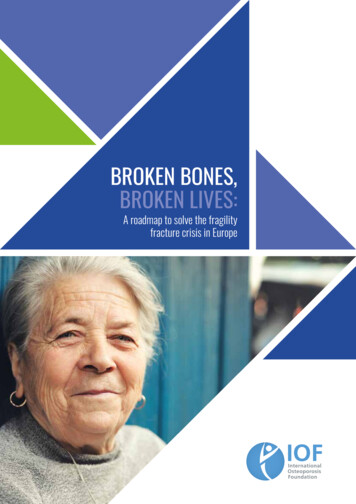
Transcription
BROKEN BONES,BROKEN LIVES:A roadmap to solve the fragilityfracture crisis in Europe
FOREWORDWith fragility fractures affecting one in threewomen and one in five men aged 50 or above,nearly everyone has a family member or friendwho has been affected by a fragility fracture.Yet how many of us stop to question the truecause of fragility fractures and simply assumethem to be a ‘normal’ sign of aging rather thanthe result of weakened bone? How many of usunderstand that an initial fracture may be agateway to further fractures and should betreated as a warning sign and prompt usto seek out preventative treatment?As Europe’s population ages, the incidence andcontribution of fragility fractures to the overallhealthcare spend continue to increase. Every year,2.7 million fractures occur across the EU6 nations(France, Germany, Italy, Spain, Sweden, andthe UK) with an associated healthcare cost of 37 billion. This annual expenditure is predictedto increase by 23% (to 47 billion) by 2030.Beyond the immediate distress, healing time,and recovery associated with a fracture, an initialfracture significantly increases the risk ofsubsequent fractures and can trigger anegative spiral of healthcare dependence,escalating expense, and impaired quality of life,despite the existence of treatments and programsfor secondary prevention of fragility fractures.This report, Broken bones, broken lives:A roadmap to solve the fragility fracture crisisin Europe, explores the clinical, societal, andcost burden associated with fragility fracturesacross the EU6 nations. The findings provideevidence that, despite the availability of effectivepreventative therapies and managementapproaches for fragility fractures, 60–85% ofwomen do not receive appropriate care.Secondary prevention of fragility fractures hasbeen neglected for too long. There is an urgentneed to recognize fragility fractures as a publichealth priority, and to establish secondaryfracture prevention and management as anintegral component of healthy aging.In addition to providing the latest state of playof fragility fracture care, the report serves as aroadmap, which includes country-specific policyrecommendations that can assist policymakersin offering the best possible care for their citizensin order to reduce the number of fractures andtheir impact on patients and healthcare systems.Cyrus Cooper, IOF PresidentThe International Osteoporosis Foundation (IOF) is a registered not-for-profit,non-governmental foundation based in Switzerland that has been grantedRoster Consultative Status with the Economic and Social Council of theUnited Nations. IOF functions as a global alliance of patient societies, researchorganizations, healthcare professionals, and international companies workingto prevent osteoporosis and fragility fractures worldwide. Striving for a worldwithout fragility fractures, in which healthy mobility is a reality for all, IOF isdedicated to advancing research and education, promoting policy change,increasing awareness of bone health, and improving patient care.The development of this report has been supported by UCB.Full publication of the data included in this report is currently in development.2Foreword
CONTENTS04Glossary05Executive summary06Did you know that 07 The silent burden of fragility fractures for individualsand healthcare systems Fragility fractures affect men and women throughout Europe– Prevalence of osteoporosis across the EU6– Lifetime risk of fragility fractures– Fragility fracture incidenceFragility fractures incur substantial healthcare costs – Fragility fractures are associated with significant healthcare costs– Fragility fractures place a high burden on patients and healthcare systems Fragility fractures have a multifaceted impact on the individualand society– Reduced independence and lifestyle impairment– Fragility fractures can significantly impact the working population– Patients suffering fragility fractures depend on care from family and friends16Fragility fractures in the context of public health priorities18 Fragility fractures are a growing challenge in the publichealth landscapeFracture-related costs are set to riseFracture-related patient burden is set to increase21Effective management can improve outcomes and reduce costsOne fragility fracture leads to another Most eligible patients do not receive treatment to prevent fragilityfractures following their first fracture Multidisciplinary models for secondary fracture prevention cancontribute to closing the treatment gapFLSs are a cost-effective option for patient management26Closing remarks27AcknowledgmentsIOF Steering CommitteeIOF Consultation Panel29Reference listContents3
GLOSSARY4BMDBone Mineral DensityCIConfidence intervalCOPDChronic obstructive pulmonary diseaseCTF Capture The Fracture DALYDisability-adjusted life yearEU6France, Germany, Italy, Spain, Sweden, and the UKFLSFracture Liaison ServiceGDPGross domestic productICERIncremental cost-effectiveness ratioICUROSInternational Costs and Utilities Related to Osteoporotic Fractures StudyIOFInternational Osteoporosis FoundationMOFMajor osteoporotic fracture (hip, spine, humerus, or forearm fractures)QALYQuality-adjusted life yearGlossary
EXECUTIVE SUMMARYThis report provides an overview and comparison of the burden andmanagement of fragility fractures in six European countries (France, Germany,Italy, Spain, Sweden, and the UK), hereafter referred to as EU6. The aim of thereport is not only to shed light on the burden of fragility fractures, but also toimprove efficiencies in fragility fracture management and ultimately improvethe care that patients deserve.As European societies are slowly aging, preservingthe independence and active lifestyles of the agingpopulation has become a multifaceted challengethat technology, social initiatives, and healthcarepolicy can help tackle.With 2.68 million new broken bones every yearin the EU6, fragility fractures are a major obstacleto healthy aging, impacting the independence andquality of life of 20 million women and men livingwith osteoporosis.Fragility fractures can be avoided, but theirprevention and management have long beenneglected despite the massive associated costson healthcare systems ( 37.5 billion). Fragilityfracture costs exceed those of many other chronicdiseases (e.g. chronic obstructive pulmonarydisease [COPD], rheumatoid arthritis,hypertension) and are set to increase to 47.4 billion by 2030.After a fragility fracture, patients are five timesmore likely to experience a second fracture withinthe next 2 years. Despite this, 60–85% of womenover 50 years of age with osteoporosis do notreceive treatment. This massive treatment gap,which is consistently observed in all geographies,reflects the low importance that has been givento fragility fractures to date, creating an extremeurgency to prioritize post-fracture care in agingsocieties before costs get out of control.As the number of fractures is expected to increaseby 23% by 2030, now is the time to break the costspiral, and take action to put an end to the direconsequences of fractures on patients.Policies have a significant role to play inpromoting, funding, and implementing caresolutions, such as coordinated care modelsfor patients following a fracture, with the mostcommon coordinated care model being a ‘FractureLiaison Service’, or FLS. The FLS model has beenproven to be both clinically effective andcost-effective: reducing further fractures, andlessening the burden on both healthcare andindividuals at a reasonable level of investment.While coordinated care models appear as auniversal solution to improve patients’ diagnosis,treatment, and follow-up, local policy solutionsadapted to the specificities of healthcare systemsand policies – within and across countries –should also be considered. Each country-specificreport that has been developed to complementthis EU6 summary will include a roadmapprioritizing policy activities that can make adifference for patients with fragility fractures.Executive summary5
DID YOU KNOW THAT. Osteoporosis (which means ‘porous bone’)is a disease that weakens the densityand quality of the bone, thus increasingthe risk of fracture. The loss of bone issymptomatically silent and progressive,until the first fragility fracture occurs dueto a low-trauma event, such as a fall fromstanding height or even a minor bump1 One in five men and one in three womenaged 50 years will experience a fragilityfracture in their remaining lifetime2 A fragility fracture is a warning sign that hasto be taken seriously: a fracture increasesthe risk of a subsequent fracture, which canoccur at a different site3 It is not only important to treat theexisting fragility fracture but also toprevent subsequent ones, i.e. secondaryfracture prevention4 “By missing the opportunity to respondto the first fracture, healthcare systemsaround the world are failing to preventthe second and subsequent fractures”(Professor Kristina Åkesson)5I was in constant pain andhad major problems in myprofessional life.Edmund, Germany6Did you know that
THE SILENT BURDEN OF FRAGILITY FRACTURESFOR INDIVIDUALS AND HEALTHCARE SYSTEMSFragility fractures affect men and women throughout EuropePrevalence of osteoporosis across the EU6Approximately 16 million4 million have osteoporosis in the EU6 (assessed in 2015).6–10Osteoporosis prevalence in adults aged 50 years is consistent across Europe:4million16million22.7%22.5% 6.8%6.9%22.5%22.5% 6.9%6.7%23.1%21.8% 6.8%7.0%The silent burden of fragility fractures for individuals and healthcare systems7
Lifetime risk of fragility fracturesThe estimated lifetime risk of experiencing a hip fracture for:11women aged50 yearsis betweenmen aged50 yearsis between9.8%6.1%22.8%13.7%totoThe lifetime risk of sustaining a fragility fracture varies for women and men, by fracture site, and by country.There is a marked difference in the risk of fracture between the EU6 countries, with Northern Europeancountries having the highest fracture rates observed worldwide.The reasons for the difference in fracture risk between countries are unknown and cannot be explained bydifferences in bone density. However, plausible factors include differences in body mass index, low calciumintake, reduced sunlight exposure and, perhaps the most crucial factor, socio-economic prosperity, which,in turn, may be related to low levels of physical activity.12,13Regardless of differences in fracture risk, the number of fractures in all countries is expected to increasedue to an increasingly elderly population.Lifetime risk offragility fracture (%)Lifetime risk of fragility fracture from the age of 50 years, by ainMOFThe silent burden of fragility fractures for individuals and healthcare menMenWomen0UK
Fragility fracture incidenceAcross the EU6, approximately 3% of women over the age of 50 suffer a new fragility fractureevery year.11,14Estimated number of fragility fractures by fracture category and country in 2017Total fracturenumbernumberTotal fractureby categoryby tebralTotal fragility fracture number and relative distribution across the EU6In total, there were2.68 million fragilityfractures in the EU6Intotal, therewerein 2017,of which2.68fragility51% millionwere MOFsfractures in the EU6in 2017, of which51% were 65%65%The silent burden of fragility fractures for individuals and healthcare systems9
Fragility fractures incur substantial healthcare costsFragility fractures are associated with significant healthcare costsIn 2017, fracture-related costs totaled an estimated 37.5 billion across the EU6 nations.Fracture-related costs:15,16mostly occur in the first year following a fracturediffer between fracture sites and, to some extent, reflect the severityof fracturetend to be highest with hip fractures, as this is the most severefracture siteEstimated annual fracture-related costs vary significantly by fracture site. (billion)Estimated annual fracture-related costs for the EU6 in lyOtherSpainMOFSwedenTotalThe silent burden of fragility fractures for individuals and healthcare systemsUKEU6
Fragility fractures place a high burden on patients and healthcare systemsThe burden of fragility fractures on individuals is demonstrated here with the annual loss ofquality-adjusted life years (QALYs).QALYS are a measure of the state of health of a person or group in which the benefits, in terms of lengthof life, are adjusted to reflect the quality of life. One QALY is equal to 1 year of life in perfect health.QALYs are calculated by estimating the years of life remaining for a patient following a particulartreatment or intervention and weighting each year with a quality-of-life score (on a 0 to 1 scale). It is oftenmeasured in terms of the patient’s ability to carry out the activities of daily life, and freedom from pain andmental disturbance.17The loss of QALYs as a result of fragility fractures varies across the EU6 countries. These differences arelargely driven by variations in the risk of fractures and age distribution between countries.11Total annual loss of QALYs by country in 2017450,000400,000Annual lost 0000FranceGermanyItalySpainSwedenUKThe silent burden of fragility fractures for individuals and healthcare systems11
Fragility fractures have a multifaceted impact on the individual and societyReduced independence and lifestyle impairmentReduced independence can be one of the most distressing outcomes for fracture patients. The disabilityassociated with hip fractures can be severe. One year after hip fracture, 40% of patients are still unable towalk independently, and 80% are restricted in other activities, such as driving and grocery shopping.18A fracture not only affects people physically, but also emotionally. Knowledgeof their increased fracture risk can negatively affect patients’ outlook, causingthem to change their levels of social interaction and to avoid certainactivities: impairing their overall quality of life.19The long-term loss of independence and mobility can put physical, emotional, and financial strain onpatients themselves, as well as relatives and friends, potentially leading to the need for institutional care.20LTC at 12 months (%)Proportion (%) in long-term care (LTC) at 12 months after a fracture by fracture type(ICUROS* Europe)111086420HipVertebralOther*International Costs and Utilities Related to Osteoporotic Fractures Study Proportion (ICUROS) Europe: Austria, Estonia, Spain,France, Italy, and SwedenThe proportion of patients moving into LTC following a hip fracture increases significantly with age, from2.1% at age 50–60 years and 35.3% above 90 years.12The silent burden of fragility fractures for individuals and healthcare systems
Fragility fractures can significantly impact the working populationMy daily life has changed completely. I now walk with two canes. I can’t benddown and I’m constantly in pain. I cannot carry things and, therefore,cannot go shopping. I miss my active life, very, very much.Inger, SwedenAlthough fragility fractures mostly affect people in later life, by which time they have retired, there area significant number of people of working age with the condition.21 Sick days taken in 2017 by non-retiredindividuals in the EU6 due to fragility fractures totaled 7,615,720 days.11Number of sick days taken after a fragility fracture, by countryNumber of sick alItalyOtherSpainSwedenUKEU6TotalThe silent burden of fragility fractures for individuals and healthcare systems13
Patients suffering fragility fractures depend on care from family and friendsAs a result of reduced mobility and ability to complete activities of daily living, individuals who have suffereda fragility fracture may rely on informal caregivers, such as family members or friends.During the first year after a fracture, the hours of care provided by relatives vary greatly by fracture typeand country.*11 The more serious the fracture, the more support is needed.Vertebral263 hours care per1,000 individualsHip370 hours care per1,000 individualsOther130 hours care per1,000 individuals* To measure the average burden placed on informal caregivers per year, survey responses from ICUROS22–24 were also used to determine the caregiverburden due to osteoporotic fracture. It was measured in terms of hours of care per year provided by relatives in ICUROS Europe (a substitute measurefor the EU6), as well as selected countries.14The silent burden of fragility fractures for individuals and healthcare systems
In countries where cross-generational support is more established, the impact of fragility fractureson caregivers is generally higher.25Relative care hours related to hip fractures per 1,000 people, by country1,000Hours of care after a hip fracture,per 1,000 nUKSpainItalyThe silent burden of fragility fractures for individuals and healthcare systems15
FRAGILITY FRACTURES IN THE CONTEXT OF PUBLICHEALTH PRIORITIESThe latest fracture, which is my third, occurred when I had flu and coughed.Anita, SwedenFragility fractures represent a health risk for individuals aged 50 or above, who have similarchances of being affected by osteoporosis as they do of having high cholesterol or high bloodpressure (two major contributors to heart disease that affect 54% and 44% of people aged 50 orabove, respectively).26The lifetime risk of sustaining a hip fracture is similar to the lifetime risk of a stroke in Europe forboth women (between 10% and 23% for hip fracture, and 20% for stroke) and men (between 6% and 14%for hip fracture, and 14% for SpainMOFFragility fractures in the context of public health MenWomenMenWomenMen0WomenLifetime risk of fragility fracture (%)Lifetime risk of fragility fracture from the age of 50 years, by country, and theequivalent risk of stroke in EuropeStroke(Europe)
The fragility fracture burden in the EU6 is greater than that of many other chronic diseases(including COPD). It is surpassed only by ischemic heart disease, dementia, and lung cancer.27Country contribution to total disability-adjusted life years (DALYs) by diseasein the EU6 in 17 selected diseasesIschemic heart diseaseDementiaLung cancerFragility fracturesCOPDIschemic strokeCirrhosis of the liverMigraineOsteoarthritisHypertensive heart diseaseAsthmaParkinson’s diseaseRheumatoid arthritisMelanoma and other skin cancersPeptic ulcer diseaseFranceMultiple nUK6,000,000Fragility fractures are the fourth leading cause of chronic disease morbidity, rising from a rankingof sixth in 2009. Across the EU6, fragility fractures now account for more than 2.6 million DALYs(a measure of the impact of a disease or injury in terms of healthy years lost17) annually, more thanfor hypertensive heart disease or rheumatoid arthritis.6Fragility fractures in the context of public health priorities17
FRAGILITY FRACTURES ARE A GROWING CHALLENGEIN THE PUBLIC HEALTH LANDSCAPEAn ever-growing public health challenge is emerging: an estimated 2.7 million new fractures occurredin the EU6 during 2017, and the incidence of fragility fractures is expected to increase by 23% (by over3.3 million fractures annually) between 2017 and 2030.3,500,000 manyItalySpain 26.2%SwedenUKFracture projections for 2017 and 2030 by countryTotalMOFHipVertebralΔ percentage change for all fragility fractures18Fragility fractures are a growing challenge in the public health landscape2030203020172030201720302017203020170 26.6%2017 28.8%2030 22.4% 24.4%2017500,0002030 18.5%1,000,0002017Total fractures by categoryEstimated number of fragility fractures by fracture category and country in 2017and 2030, including percentage change for all fragility fracturesTotalEU6
Fracture-related costs are set to riseFracture-related costs are projected to increase between 2017 and 2030.11 47.4 billion2030%27 37.5 billion2017Estimated annual fracture-related costs in 2017 and 2030, and percentage changefor the EU6 30.6%50 (billion)40302010020172030Fracture cost projectionsVertebralOtherHipMOFTotalAlthough hip fractures make up 1/5 of total fractures, they areestimated to incur an estimated 56% of total fracture-related costsAcross the EU6 countries, the greatest increases in costs are expected to be seen in:Spain(30.6%) andThe UK(30.2%), withGermany expectedto see the lowestincrease (23.2%)Fragility fractures are a growing challenge in the public health landscape19
Fracture-related patient burden is set to increaseBased on population projections, the QALY losses from 2017 up to 2030 across the EU6 have beenestimated, showing an increase of approximately one-quarter over this rmanyItalyΔ percentage change for all fragility fractures20Fragility fractures are a growing challenge in the public health 00,000150,000100,00050,00002017Annual lost QALYsTotal annual loss of QALYs by country in 2017 and 2030, and percentage changeUK
EFFECTIVE MANAGEMENT CAN IMPROVEOUTCOMES AND REDUCE COSTSIf the fracture I suffered in my spine had been spotted earlier than it was,I would have been spared a great deal of pain and suffering.Christine, UKOne fragility fracture leads to anotherFor women aged 50 to 80, after their first fragility fracture, their risk of a subsequent fracture within the firstyear after a fracture is five times greater than women who have not had a prior fracture.28Subsequent fracture risk is highest in the first 2 years following an initial fracture, when there is animminent risk of another fracture at the same, or other, sites.29 This is why it is critically importantto identify patients as soon as possible after fracture to optimize fracture prevention treatments and keepthe patient from having another fracture.Similar patterns of imminent fracture risk have been observed in most countries evaluated,15,16but between-country comparisons are restricted by limited data availability.Relative risk of all subsequent fractures calculated as a mean from the first fracture(grey line) and per separate year of follow-up (orange line)6Relative risk54321002468101214161820Follow-up (years)Adapted from van Geel et al.28Effective management can improve outcomes and reduce costs21
Most eligible patients do not receive treatment to prevent fragility fractures followingtheir first fractureThere is indeed one thing I have learned: that an accurate diagnosis, which isrelatively simple, can save women from a lot of suffering, fractures,and emotional damage.Carmen, SpainWith appropriate medical treatment, many fragility fractures can be avoided.The guidelines recommend that all patients should receive treatment after suffering a fragilityfracture – unfortunately this is not always the case with 60–85% of women not receiving treatmentfollowing a fracture.30The proportion of women aged 50 years or more that are not treated within a year of an osteoporoticfracture varies by e types by countryProportion (%) of female patients (50 years and above) untreated within a yearof osteoporotic fractureSwedenUK0102030405060Women aged 50 years and above (%)22Effective management can improve outcomes and reduce costs708090
Multidisciplinary models for secondary fracture prevention can contribute to closingthe treatment gapPost-fracture coordinated care models, such as a Fracture Liaison Service(FLS), are multidisciplinary healthcare delivery models for secondary fractureprevention. Systematically, they aim to identify, diagnose, and treat (by referral)all eligible patients within a local population who have suffered a fragilityfracture, with the aim of reducing risk of subsequent fractures. In the FLS model,care is usually coordinated by a dedicated, specialist nurse who helps patientsnavigate the way through the various departments of relevance (e.g. orthopedicsurgery, radiology, and primary care).Post-fracture coordinated care models, like FLSs, offer the potential for a cost-effective care deliverymodel that reduces the risk of re-fracture and mortality by increasing the number of patients beingtreated and improving adherence to treatment.5,31–36 Data published from the FLS in Glasgow, Scotland,showed that FLSs are cost-effective for the prevention of further fractures in fragility fracture patients,resulting in fewer fractures and cost savings for healthcare systems.5,33A recently published systematic literature review and meta-analysis based on 159 scientific publicationshighlighted the benefits of FLSs:37Outcomemeasure37Effect of FLS(absolute change)95% CIDuration offollow-up (months)Number ofstudies includedBMD testing 24%0.18 to 0.293–2637Treatment initiation 20%0.16 to 0.253–7246Treatmentadherence 22%0.13 to 0.313–489Re-fracture rate–5%–0.08 to –0.036–7211Mortality–3%–0.05 to –0.016–7215BMD, Bone Mineral DensityEffective management can improve outcomes and reduce costs23
However, not all FLSs are the same between and within countries. FLSs vary in the services they offer,from identifying and informing patients without taking further action, to more comprehensive models thatinclude investigating, treating, and monitoring patients. This variation in structure affects the level of impacton health outcomes.36The effect of different models of care on osteoporosis treatment and frequency of BMD testing wereevaluated in a meta-analysis by Ganda et al.38A meta-analysis demonstrated that adoption of the 3 “I” model, with core priorities of Identify, Investigate and Intervene, offeredgreater effectiveness in patient assessment and treatment than 0–2 “I” models3 ”I” modelIdentify,Investigate,Intervene79% receive BMD testing46% receive osteoporosistreatment2 ”I” modelIdentify,Investigate60% receive BMD testing41% receive osteoporosistreatment1 ”I” modelIdentify43% receive BMD testing23% receive osteoporosistreatment0 ”I” modelNo studies on BMD testing8% receive osteoporosistreatmentAdapted from Ganda et al.38The analyses by both Ganda et al. and Wu et al. showed dramatic increases in BMD testing andosteoporosis treatment initiation, which further support the value of post-fracture care coordinationto prevent fragility fractures and reduce the overall cost of care for these patients.37,38Capture The Fracture (CTF ): A global initiative of IOFCTF aims to ‘facilitate the implementation of coordinated, multidisciplinarymodels of care for secondary fracture prevention’. CTF has created a set ofinternationally endorsed standards and guides for best practice to bridge thegap between FLS providers and to help in the development and implementationof new FLSs. CTF includes the largest network of individual FLS providers in theworld. Providers undergo a CTF audit to determine service quality, with a gold,silver, or bronze star awarded.There are huge variations between and within countries in terms ofthe availability of coordinated care models. A CTF survey reported thatsuch models only existed for 2.8% of responders in Italy and up to 37.5%of responders in Sweden for hospital referrals, reducing to 1–10% forgeneral practitioner referrals. In contrast, in the UK, the National OsteoporosisSociety estimated that 55% of the UK population has access to an FLS.24Effective management can improve outcomes and reduce costs
FLSs are a cost-effective option for patient managementThe cost of improving patient outcomes within an FLS has been estimated to be:39,40 22,700–26,000 14,029per QALY saved;ICER post-hip fractureper QALY saved; ICERICER, incremental cost-effectiveness ratio (a statistic used to summarize the cost-effectiveness of a healthcare intervention)A recent health economic analysis estimated that the comprehensive introduction of FLSs across the EU6nations could achieve the following cost benefits:37Cost implications of extending an FLS to all individuals over 50 years acrossthe EU6 nationsCostreduction 39.7million8,858QALYsQALYssavedICER: 3,108per QALY savedBased on an ICER value of 3,108 per QALY saved, the FLSs model to identify, evaluate, and treat patientswith osteoporosis medications after fracture demonstrates that post-fracture care is a significantlycost-effective interventional approach to improve overall outcomes and reduce costs. By comparison,the ICER value for a stroke service model in post-stroke care was found to be 11,685 saved per QALYgained,41 which showed that an FLS is markedly more effective than the more commonly utilized post-strokecare regimen.The World Health Organization provides guidance on how an intervention with a benefit expressed in QALYvalue equivalent to 1 year’s gross domestic product (GDP) per capita or less is considered to be reasonableexpenditure, representing the likelihood of achieving at least 1 additional year of healthy life per capita. 42With the GDP per capita in the EU6 ranging from 32,405 (Spain) to 56,935 (Sweden), 43 investment in FLSsis recommended as it qualifies as one of the most cost-effective interventions available to help managethe growing crisis of fragility fractures and osteoporosis.Effective management can improve outcomes and
This report, Broken bones, broken lives: A roadmap to solve the fragility fracture crisis in Europe, explores the clinical, societal, and . in which healthy mobility is a reality for all, IOF is dedicated to advancing research and education, promoting policy change, increasing awareness of bone health, and improving patient care. .
